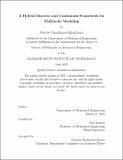A Hybrid Discrete and Continuum Framework for Multiscale Modeling
Author(s)
Chantharayukhonthorn, Maytee
DownloadThesis PDF (44.58Mb)
Advisor
Kamrin, Ken
Terms of use
Metadata
Show full item recordAbstract
From the agricultural and industrial products that use granular ingredients, to the geological systems below our feet, granular systems surround us. Developing a computational framework to simulate granular materials is thus a gateway into understanding and improving many aspects of our lives. However, what make them beautiful and interesting systems are also what make them difficult to simulate. They span many length scales: individual grains can be measured on the scale of micrometers yet are the building blocks of kilometer-scale geological phenomena. They are also multiphase: an hourglass, for example, has a liquid-like region of flowing grains; a gas-like region of grains that are falling, dilute, and colliding; and a solid-like region of static grains that collect at the bottom.
This work builds upon nascent hybridization work that combines two simulation methodologies: discrete methods and continuum methods. Discrete methods model every single grain and are thus accurate; however, they scale poorly. By contrast, continuum methods can be faster by greatly reducing the degrees of freedom represented. However, they can lose accuracy due to homogenization of system behavior. The hybrid method is able to utilize both a discrete representation for complex, constitutive behavior and a continuum representation for larger scale regions of simplified behavior. The method can homogenize discrete grains into continuum, enrich continuum regions into discrete grains, and then couple these systems in a hybrid zone. The hybrid method thus bridges both the variation in length scale and multiphase nature of grains.
In this study we present work on all components of the hybrid method. First, we introduce new granular packing methods capable of generating ad hoc granular assemblies that can meet user-defined criteria. Second, we discuss new enrichment and homogenization operators that conserve mass and momentum while also preserving higher-order properties. Finally, we discuss a higher order hybrid coupling, which better represents the two disparate simulation methods at the grid level. With these updates to the hybrid method, we demonstrate the ability to simulate large length and time scale granular systems in geometries of academic and industrial relevance. Transient and steady state behavior comparable to that of discrete methods is shown with the computational speed of continuum methods. We also show the ability to simulate systems too large for pure discrete methods. In summary, we demonstrate that the hybrid method is able to accurately simulate granular systems and is computationally efficient and robust enough to open the door to once-intractable system scales.
Date issued
2023-06Department
Massachusetts Institute of Technology. Department of Mechanical EngineeringPublisher
Massachusetts Institute of Technology